Rigol DSG836, DSG821, DSG815, DSG821A, DSG830 Programming Guide
...RIGOL
Programming Guide
DSG800 Series RF Signal Generator
Sept. 2018
RIGOL (SUZHOU) TECHNOLOGIES, INC.

RIGOL
Guaranty and Declaration
Copyright
© 2015 RIGOL (SUZHOU) TECHNOLOGIES, INC. All Rights Reserved.
Trademark Information
RIGOL is a registered trademark of RIGOL (SUZHOU) TECHNOLOGIES, INC.
Publication Number
PGG02104-1110
Software Version
00.01.07
Software upgrade might change or add product features. Please acquire the latest version of the manual from RIGOL website or contact RIGOL to upgrade the software.
Notices
RIGOL products are covered by P.R.C. and foreign patents, issued and pending.
RIGOL reserves the right to modify or change parts of or all the specifications and pricing policies at company’s sole decision.
Information in this publication replaces all previously corresponding material.
Information in this publication is subject to change without notice.
RIGOL shall not be liable for either incidental or consequential losses in connection with the furnishing, use, or performance of this manual, as well as any information contained.
Any part of this document is forbidden to be copied, photocopied, or rearranged without prior written approval of RIGOL.
Product Certification
RIGOL guarantees this product conforms to the national and industrial standards in China as well as the ISO9001:2015 standard and the ISO14001:2015 standard. Other international standard conformance certification is in progress.
Contact Us
If you have any problem or requirement when using our products or this manual, please contact RIGOL. E-mail: service@rigol.com
Website: www.rigol.com
DSG800 Programming Guide |
I |

RIGOL
Safety Requirement
General Safety Summary
Please review the following safety precautions carefully before putting the instrument into operation so as to avoid any personal injury or damage to the instrument and any product connected to it. To prevent potential hazards, please follow the instructions specified in this manual to use the instrument properly.
Use Proper Power Cord.
Only the exclusive power cord designed for the instrument and authorized for use within the local country could be used.
Ground the Instrument.
The instrument is grounded through the Protective Earth lead of the power cord. To avoid electric shock, connect the earth terminal of the power cord to the Protective Earth terminal before connecting any input or output terminals.
Connect the Probe Correctly.
If a probe is used, the probe ground lead must be connected to earth ground. Do not connect the ground lead to high voltage. Improper way of connection could result in dangerous voltages being present on the connectors, controls or other surfaces of the oscilloscope and probes, which will cause potential hazards for operators.
Observe All Terminal Ratings.
To avoid fire or shock hazard, observe all ratings and markers on the instrument and check your manual for more information about ratings before connecting the instrument.
Use Proper Overvoltage Protection.
Ensure that no overvoltage (such as that caused by a bolt of lightning) can reach the product. Otherwise, the operator might be exposed to the danger of an electric shock.
Do Not Operate Without Covers.
Do not operate the instrument with covers or panels removed.
Do Not Insert Objects Into the Air Outlet.
Do not insert objects into the air outlet, as doing so may cause damage to the instrument.
Use Proper Fuse.
Please use the specified fuses.
Avoid Circuit or Wire Exposure.
Do not touch exposed junctions and components when the unit is powered on.
Do Not Operate With Suspected Failures.
If you suspect that any damage may occur to the instrument, have it inspected by RIGOL authorized personnel before further operations. Any maintenance, adjustment or replacement especially to circuits or accessories must be performed by RIGOL authorized personnel.
Provide Adequate Ventilation.
Inadequate ventilation may cause an increase of temperature in the instrument, which would cause damage to the instrument. So please keep the instrument well ventilated and inspect the air outlet and the fan regularly.
Do Not Operate in Wet Conditions.
To avoid short circuit inside the instrument or electric shock, never operate the instrument in a humid
II |
DSG800 Programming Guide |

RIGOL
environment.
Do Not Operate in an Explosive Atmosphere.
To avoid personal injuries or damage to the instrument, never operate the instrument in an explosive atmosphere.
Keep Instrument Surfaces Clean and Dry.
To avoid dust or moisture from affecting the performance of the instrument, keep the surfaces of the instrument clean and dry.
Prevent Electrostatic Impact.
Operate the instrument in an electrostatic discharge protective environment to avoid damage induced by static discharges. Always ground both the internal and external conductors of cables to release static before making connections.
Use the Battery Properly.
Do not expose the battery (if available) to high temperature or fire.
Keep it out of the reach of children. Improper change of a battery (lithium battery) may cause an explosion. Use the RIGOL specified battery only.
Handle with Caution.
Please handle with care during transportation to avoid damage to keys, knobs, interfaces, and other parts on the panels.
DSG800 Programming Guide |
III |
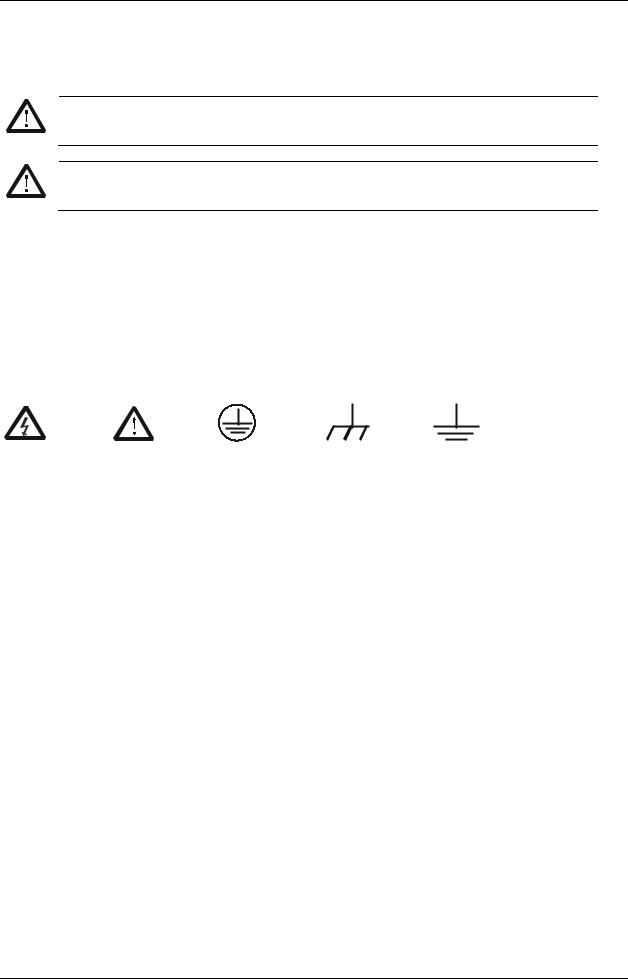
RIGOL
Safety Notices and Symbols
Safety Notices in this Manual:
WARNING
Indicates a potentially hazardous situation or practice which, if not avoided, will result in serious injury or death.
CAUTION
Indicates a potentially hazardous situation or practice which, if not avoided, could result in damage to the product or loss of important data.
Safety Terms on the Product:
DANGER It calls attention to an operation, if not correctly performed, could result in injury or hazard immediately.
WARNING It calls attention to an operation, if not correctly performed, could result in potential injury or hazard.
CAUTION It calls attention to an operation, if not correctly performed, could result in damage to the product or other devices connected to the product.
Safety Symbols on the Product:
Hazardous |
Safety |
Protective |
Chassis |
Test |
Voltage |
Warning |
Earth |
Ground |
Ground |
|
|
Terminal |
|
|
IV |
DSG800 Programming Guide |

RIGOL
Allgemeine Sicherheits Informationen
Überprüfen Sie diefolgenden Sicherheitshinweise sorgfältigumPersonenschädenoderSchäden am Gerätundan damit verbundenen weiteren Gerätenzu vermeiden. Zur Vermeidung vonGefahren, nutzen Sie bitte das Gerät nur so, wiein diesem Handbuchangegeben.
Um Feuer oder Verletzungen zu vermeiden, verwenden Sie ein ordnungsgemäßes Netzkabel.
Verwenden Sie für dieses Gerät nur das für ihr Land zugelassene und genehmigte Netzkabel.
Erden des Gerätes.
Das Gerät ist durch den Schutzleiter im Netzkabel geerdet. Um Gefahren durch elektrischen Schlag zu vermeiden, ist es unerlässlich, die Erdung durchzuführen. Erst dann dürfen weitere Einoder Ausgänge verbunden werden.
Anschluss einesTastkopfes.
Die Erdungsklemmen der Sonden sindauf dem gleichen Spannungspegel des Instruments geerdet. SchließenSie die Erdungsklemmen an keine hohe Spannung an.
Beachten Sie alle Anschlüsse.
Zur Vermeidung von Feuer oder Stromschlag, beachten Sie alle Bemerkungen und Markierungen auf dem Instrument. Befolgen Sie die Bedienungsanleitung für weitere Informationen, bevor Sie weitere Anschlüsse an das Instrument legen.
Verwenden Sie einen geeigneten Überspannungsschutz.
Stellen Sie sicher, daß keinerlei Überspannung (wie z.B. durch Gewitter verursacht) das Gerät erreichen kann. Andernfallsbestehtfür den Anwender die GefahreinesStromschlages.
Nicht ohne Abdeckung einschalten.
Betreiben Sie das Gerät nicht mit entfernten Gehäuse-Abdeckungen.
Betreiben Sie das Gerät nicht geöffnet.
Der Betrieb mit offenen oder entfernten Gehäuseteilen ist nicht zulässig. Nichts in entsprechende Öffnungen stecken (Lüfter z.B.)
Passende Sicherung verwenden.
Setzen Sie nur die spezifikationsgemäßen Sicherungen ein.
Vermeiden Sie ungeschützte Verbindungen.
Berühren Sie keine unisolierten Verbindungen oder Baugruppen, während das Gerät in Betrieb ist.
Betreiben Sie das Gerät nicht im Fehlerfall.
Wenn Sie am Gerät einen Defekt vermuten, sorgen Sie dafür, bevor Sie das Gerät wieder betreiben, dass eine Untersuchung durch RIGOL autorisiertem Personal durchgeführt wird. Jedwede Wartung, Einstellarbeiten oder Austausch von Teilen am Gerät, sowie am Zubehör dürfen nur von RIGOL autorisiertem Personal durchgeführt werden.
Belüftung sicherstellen.
Unzureichende Belüftung kann zu Temperaturanstiegen und somit zu thermischen Schäden am Gerät führen. Stellen Sie deswegen die Belüftung sicher und kontrollieren regelmäßig Lüfter und Belüftungsöffnungen.
Nicht in feuchter Umgebung betreiben.
Zur Vermeidung von Kurzschluß im Geräteinneren und Stromschlag betreiben Sie das Gerät bitte niemals in feuchter Umgebung.
Nicht in explosiver Atmosphäre betreiben.
Zur Vermeidung von Personenund Sachschäden ist es unumgänglich, das Gerät ausschließlich fernab
DSG800 Programming Guide |
V |

RIGOL
jedweder explosiven Atmosphäre zu betreiben.
Geräteoberflächen sauber und trocken halten.
Um den Einfluß von Staub und Feuchtigkeit aus der Luft auszuschließen, halten Sie bitte die Geräteoberflächen sauber und trocken.
Schutz gegen elektrostatische Entladung (ESD).
Sorgen Sie für eine elektrostatisch geschützte Umgebung, um somit Schäden und Funktionsstörungen durch ESD zu vermeiden. Erden Sie vor dem Anschluß immer Innenund Außenleiter der Verbindungsleitung, um statische Aufladung zu entladen.
Die richtige Verwendung desAkku.
Wenneine Batterieverwendet wird, vermeiden Sie hohe Temperaturen bzw. Feuer ausgesetzt werden. Bewahren Sie es außerhalbder Reichweitevon Kindern auf. UnsachgemäßeÄnderung derBatterie (Anmerkung: Lithium-Batterie) kann zu einer Explosion führen. VerwendenSie nur von RIGOL angegebenenAkkus.
Sicherer Transport.
Transportieren Sie das Gerät sorgfältig (Verpackung!), um Schäden an Bedienelementen, Anschlüssen und anderen Teilen zu vermeiden.
VI |
DSG800 Programming Guide |
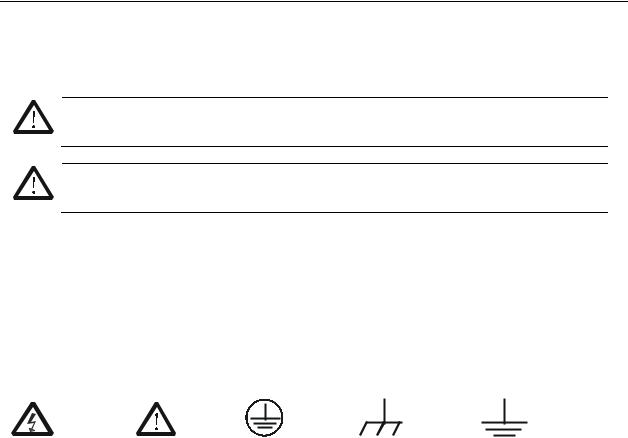
RIGOL
Sicherheits Begriffe und Symbole
Begriffe in diesem Guide:
WARNING
Die Kennzeichnung WARNING beschreibt Gefahrenquellen die leibliche Schäden oder den Tod von Personen zur Folge haben können.
CAUTION
Die Kennzeichnung Caution (Vorsicht) beschreibt Gefahrenquellen die Schäden am Gerät hervorrufen können.
Begriffe auf dem Produkt:
DANGER weist auf eine Verletzung oder Gefährdung hin, die sofort geschehen kann. WARNING weist auf eine Verletzung oder Gefährdung hin, die möglicherweise nicht sofort
geschehen.
CAUTION weist auf eine Verletzung oder Gefährdung hin und bedeutet, dass eine mögliche
Beschädigung des Instruments oder anderer Gegenstände auftreten kann.
Symbole auf dem Produkt:
Gefährliche |
Sicherheits- |
Schutz-erde |
Gehäusemasse |
Erde |
|
Spannung |
Hinweis |
||||
|
|
|
DSG800 Programming Guide |
VII |
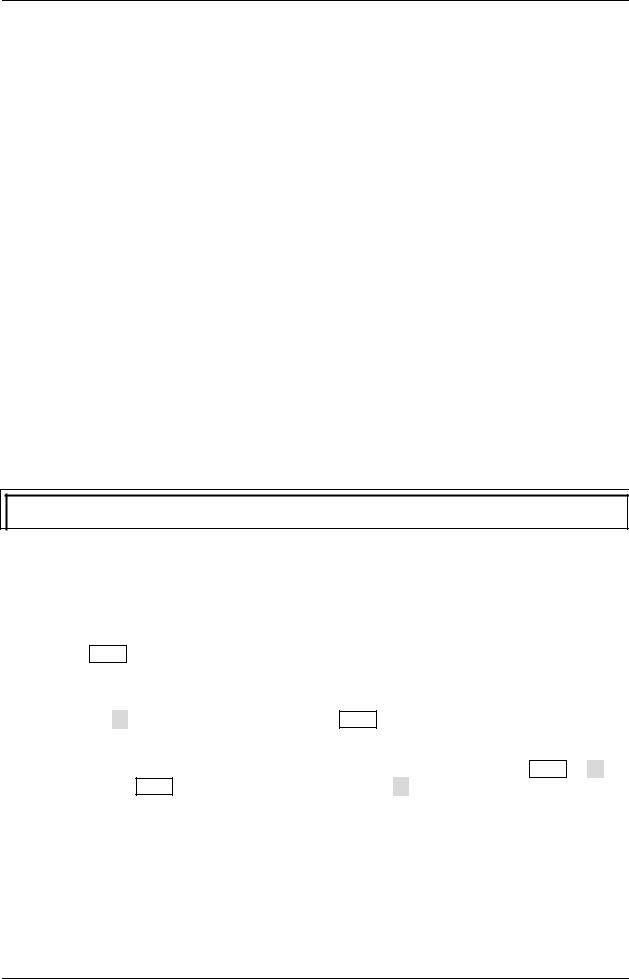
RIGOL
Document Overview
This manual introduces how to program the RF signal generator over the remote interfaces in details.
Main Topics in this Manual:
Chapter 1 Programming Overview
This chapter outlines how to build the remote communication between the RF signal generator and PC and how to control the RF signal generator remotely. Besides, it also provides a brief introduction of the SCPI commands.
Chapter 2 Command System
This chapter introduces the syntax, function, parameter and using instruction of each DSG800 command in alphabetical order (from A to Z).
Chapter 3 Application Examples
This chapter provides the application examples of the main functions of the RF signal generator. In the application examples, a series of commands are combined to realize the basic functions of the RF signal generator.
Chapter 4 Programming Demos
This chapter introduces how to program and control DSG800 using development tools, such as Visual C++, Visual Basic and LabVIEW.
Chapter 5 Appendix
This chapter provides various information, such as factory setting list.
Tip
The latest version of this manual can be downloaded from www.rigol.com.
Format Conventions in this Manual:
1.Key
The key at the front panel is denoted by the format of "Key Name (Bold) + Text Box" in the manual. For example, FREQ denotes the FREQ key.
2.Menu
The menu item is denoted by the format of "Menu Word (Bold) + Character Shading" in the manual. For example, LF denotes the "LF" menu item under FREQ.
3.Operation Step
The next step of operation is denoted by an arrow "" in the manual. For example, FREQ LF denotes pressing FREQ at the front panel and then pressing LF.
Content Conventions in this Manual:
DSG800 series RF signal generator includes DSG830 and DSG815. The introductions of the DSG800 series commands in this manual are based on DSG830, unless otherwise noted.
VIII |
DSG800 Programming Guide |
Contents |
|
RIGOL |
Contents |
|
|
Guaranty and Declaration ......................................................................................................... |
I |
|
Safety Requirement.................................................................................................................. |
II |
|
General Safety Summary............................................................................................................. |
II |
|
Safety Notices and Symbols......................................................................................................... |
IV |
|
Allgemeine Sicherheits Informationen ........................................................................................... |
V |
|
Sicherheits Begriffe und Symbole............................................................................................... |
VII |
|
Document Overview ............................................................................................................. |
VIII |
|
Chapter 1 |
Programming Overview...................................................................................... |
1-1 |
To Build Remote Communication ............................................................................................... |
1-2 |
|
Remote Control Methods........................................................................................................... |
1-3 |
|
SCPI Command Overview.......................................................................................................... |
1-4 |
|
Syntax............................................................................................................................... |
1-4 |
|
Symbol Description ............................................................................................................ |
1-4 |
|
Parameter Type.................................................................................................................. |
1-5 |
|
Command Abbreviation ...................................................................................................... |
1-5 |
|
Chapter 2 |
Command System............................................................................................... |
2-1 |
IEEE488.2 Common Commands................................................................................................. |
2-2 |
|
*IDN? ............................................................................................................................... |
2-2 |
|
*TRG ................................................................................................................................ |
2-2 |
|
:MMEMory Commands .............................................................................................................. |
2-3 |
|
:MMEMory:CATalog ............................................................................................................ |
2-3 |
|
:MMEMory:CATalog:LENGth ................................................................................................ |
2-4 |
|
:MMEMory:COPY................................................................................................................ |
2-4 |
|
:MMEMory:DATA:IQ ........................................................................................................... |
2-5 |
|
:MMEMory:DATA:IQ:LIST ................................................................................................... |
2-5 |
|
:MMEMory:DELete.............................................................................................................. |
2-6 |
|
:MMEMory:DISK:FORMat.................................................................................................... |
2-6 |
|
:MMEMory:DISK:INFormation ............................................................................................. |
2-6 |
|
:MMEMory:FILEtype ........................................................................................................... |
2-7 |
|
:MMEMory:LDISk:SPACe..................................................................................................... |
2-7 |
|
:MMEMory:LOAD................................................................................................................ |
2-7 |
|
:MMEMory:MDIRectory....................................................................................................... |
2-8 |
|
:MMEMory:MOVE ............................................................................................................... |
2-8 |
|
:MMEMory:PNAMe:EDIT ..................................................................................................... |
2-9 |
|
:MMEMory:PNAMe:STATe.................................................................................................... |
2-9 |
|
:MMEMory:SAVe............................................................................................................... |
2-10 |
|
:OUTPut Command................................................................................................................. |
2-11 |
|
:OUTPut[:STATe].............................................................................................................. |
2-11 |
|
:SOURce Commands............................................................................................................... |
2-12 |
|
[:SOURce]:AM Command Subsystem................................................................................. |
2-12 |
|
[:SOURce]:CORRection Command Subsystem.................................................................... |
2-18 |
|
[:SOURce]:FM Command Subsystem................................................................................. |
2-20 |
|
[:SOURce]:FMPM:TYPE..................................................................................................... |
2-25 |
|
[:SOURce]:FREQuency Command Subsystem .................................................................... |
2-26 |
|
[:SOURce]:INPut:TRIGger:SLOPe...................................................................................... |
2-27 |
|
[:SOURce]:IQ Command Subsystem ................................................................................. |
2-28 |
|
[:SOURce]:LEVel Command Subsystem ............................................................................. |
2-41 |
|
[:SOURce]:LFOutput Command Subsystem........................................................................ |
2-43 |
|
[:SOURce]:MODulation:STATe........................................................................................... |
2-45 |
|
[:SOURce]:PM Command Subsystem................................................................................. |
2-46 |
|
[:SOURce]:PULM Command Subsystem............................................................................. |
2-51 |
|
[:SOURce]:SWEep Command Subsystem........................................................................... |
2-61 |
|
DSG800 Programming Guide |
IX |

RIGOL |
Contents |
:STATus Commands................................................................................................................. |
2-78 |
:STATus:OPERation:CONDition........................................................................................... |
2-81 |
:STATus:OPERation:ENABle ............................................................................................... |
2-81 |
:STATus:OPERation[:EVENt] .............................................................................................. |
2-81 |
:STATus:QUEStionable:CALibration:CONDition .................................................................... |
2-82 |
:STATus:QUEStionable:CALibration:ENABle......................................................................... |
2-83 |
:STATus:QUEStionable:CALibration[:EVENt]........................................................................ |
2-83 |
:STATus:QUEStionable:CONDition ...................................................................................... |
2-83 |
:STATus:QUEStionable:CONNect:CONDition........................................................................ |
2-84 |
:STATus:QUEStionable:CONNect:ENABle ............................................................................ |
2-85 |
:STATus:QUEStionable:CONNect[:EVENt] ........................................................................... |
2-85 |
:STATus:QUEStionable:ENABle........................................................................................... |
2-85 |
:STATus:QUEStionable[:EVENt].......................................................................................... |
2-86 |
:STATus:QUEStionable:FREQuency:CONDition .................................................................... |
2-87 |
:STATus:QUEStionable:FREQuency:ENABle......................................................................... |
2-88 |
:STATus:QUEStionable:FREQuency[:EVENt]........................................................................ |
2-88 |
:STATus:QUEStionable:MODulation:CONDition.................................................................... |
2-89 |
:STATus:QUEStionable:MODulation:ENABle ........................................................................ |
2-90 |
:STATus:QUEStionable:MODulation[:EVENt] ....................................................................... |
2-90 |
:STATus:QUEStionable:POWer:CONDition........................................................................... |
2-91 |
:STATus:QUEStionable:POWer:ENABle ............................................................................... |
2-92 |
:STATus:QUEStionable:POWer[:EVENt] .............................................................................. |
2-92 |
:STATus:QUEStionable:SELFtest:CONDition ........................................................................ |
2-93 |
:STATus:QUEStionable:SELFtest:ENABle............................................................................. |
2-94 |
:STATus:QUEStionable:SELFtest[:EVENt]............................................................................ |
2-94 |
:STATus:QUEStionable:TEMP:CONDition............................................................................. |
2-95 |
:STATus:QUEStionable:TEMP:ENABle ................................................................................. |
2-96 |
:STATus:QUEStionable:TEMP[:EVENt] ................................................................................ |
2-96 |
:SYSTem Commands ............................................................................................................... |
2-97 |
:SYSTem:BRIGhtness........................................................................................................ |
2-98 |
:SYSTem:CLEar ................................................................................................................ |
2-98 |
:SYSTem:COMMunication:INTerface................................................................................... |
2-98 |
:SYSTem:COMMunication:LAN:DHCP.................................................................................. |
2-99 |
:SYSTem:COMMunication:LAN:IP:ADDress ......................................................................... |
2-99 |
:SYSTem:COMMunication:LAN:IP:AUTO ........................................................................... |
2-100 |
:SYSTem:COMMunication:LAN:IP:GATeway ...................................................................... |
2-100 |
:SYSTem:COMMunication:LAN:IP:MANual ........................................................................ |
2-101 |
:SYSTem:COMMunication:LAN:IP:SET .............................................................................. |
2-101 |
:SYSTem:COMMunication:LAN:IP:SUBnet:MASK ............................................................... |
2-102 |
:SYSTem:COMMunication:LAN:RESet ............................................................................... |
2-102 |
:SYSTem:COMMunication:LAN[:SELF]:PREFerred.............................................................. |
2-102 |
:SYSTem:DATE ............................................................................................................... |
2-103 |
:SYSTem:DISPlay:UPDate[:STATe]................................................................................... |
2-103 |
:SYSTem:FSWitch:STATe ................................................................................................. |
2-104 |
:SYSTem:LANGuage........................................................................................................ |
2-104 |
:SYSTem:LKEY ............................................................................................................... |
2-105 |
:SYSTem:POWer:ON:TYPE .............................................................................................. |
2-105 |
:SYSTem:PRESet ............................................................................................................ |
2-106 |
:SYSTem:PRESet:TYPE.................................................................................................... |
2-106 |
:SYSTem:PRESet:SAVE.................................................................................................... |
2-106 |
:SYSTem:TIME ............................................................................................................... |
2-107 |
:SYSTem:TIME:STATe ..................................................................................................... |
2-107 |
:TRIGger Commands............................................................................................................. |
2-108 |
:TRIGger:IQ[:IMMediate]................................................................................................ |
2-108 |
:TRIGger:PULSe[:IMMediate] .......................................................................................... |
2-108 |
:TRIGger[:SWEep][:IMMediate] ...................................................................................... |
2-108 |
:UNIT Command ................................................................................................................... |
2-109 |
:UNIT:POWer ................................................................................................................. |
2-109 |
X |
DSG800 Programming Guide |
Contents |
|
RIGOL |
Chapter 3 |
Application Examples |
.........................................................................................3-1 |
To Output RF signal .................................................................................................................. |
3-2 |
|
To Output RF Sweep Signal ....................................................................................................... |
3-2 |
|
To Output RF Modulated Signal.................................................................................................. |
3-3 |
|
Chapter 4 |
Programming Demos.......................................................................................... |
4-1 |
Programming Preparations ........................................................................................................ |
4-2 |
|
Excel Programming Demo ......................................................................................................... |
4-3 |
|
Matlab Programming Demo ....................................................................................................... |
4-7 |
|
LabVIEW Programming Demo.................................................................................................... |
4-8 |
|
Visual Basic Programming Demo.............................................................................................. |
4-12 |
|
Visual C++ Programming Demo .............................................................................................. |
4-15 |
|
Chapter 5 |
Appendix ............................................................................................................ |
5-1 |
Appendix A: Factory Setting ...................................................................................................... |
5-1 |
|
Appendix B: Warranty ............................................................................................................... |
5-4 |
|
DSG800 Programming Guide |
XI |
Chapter 1 Programming Overview |
RIGOL |
Chapter 1 Programming Overview
This chapter introduces how to build the remote communication between the instrument and PC and provides an overview of the syntax, abbreviation rules and status system of the SCPI commands.
Main topics of this chapter:
To Build Remote Communication
Remote Control Methods
SCPI Command Overview
DSG800 Programming Guide |
1-1 |
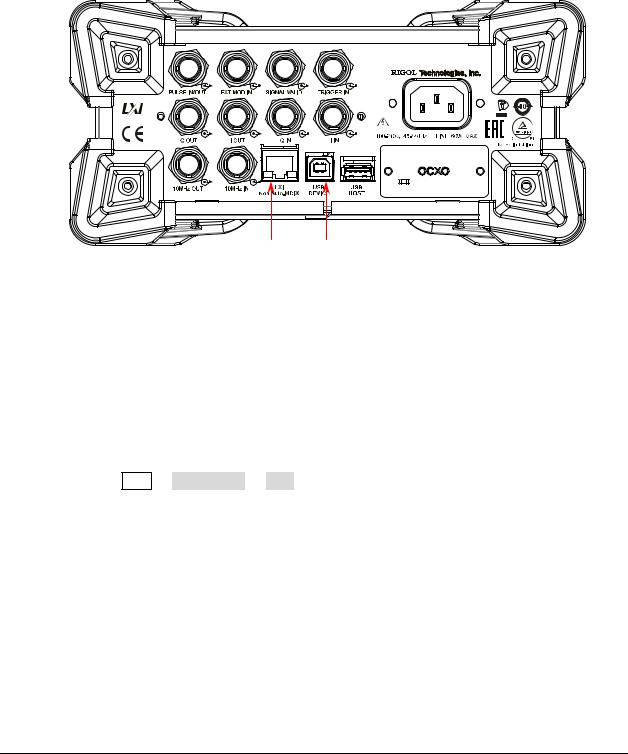
RIGOL |
Chapter 1 Programming Overview |
To Build Remote Communication
You can build the remote communication between DSG800 and the PC via USB or LAN interface.
Operating Steps:
1.Install the Ultra Sigma common PC software
Acquire the Ultra Sigma common PC software from www.rigol.com; then, install it according to the instructions.
2.Connect the instrument and PC and configure the interface parameters of the instrument
DSG800 supports USB and LAN communication interfaces, as shown in the figure below.
LAN USB DEVICE
Figure 1-1 DSG800 Communication Interfaces
(1)Use the USB interface:
Connect the USB DEVICE interface at the rear panel of DSG800 and the USB HOST interface of the PC using a USB cable.
(2)Use the LAN interface:
Make sure that your PC is connected to the local network.
Check whether your local network supports DHCP or auto IP mode. If not, you need to acquire the network interface parameters available, including the IP address, subnet mask, gateway and DNS.
Connect DSG800 to the local network using a network cable.
Press Syst I/O Config LAN to configure the IP address, subnet mask, gateway and DNS of the instrument.
3.Check whether the connection is successful
Start-up Ultra Sigma, search for the RF signal generator resource, right-click the resource name and select "SCPI Panel Control" from the pop-up menu. Enter the correct command in the pop-up SCPI control panel and click Send Command, Read Response or Send&Read to check whether the connection is successful, as shown in the figure on the next page (take the USB interface as an example).
1-2 |
DSG800 Programming Guide |
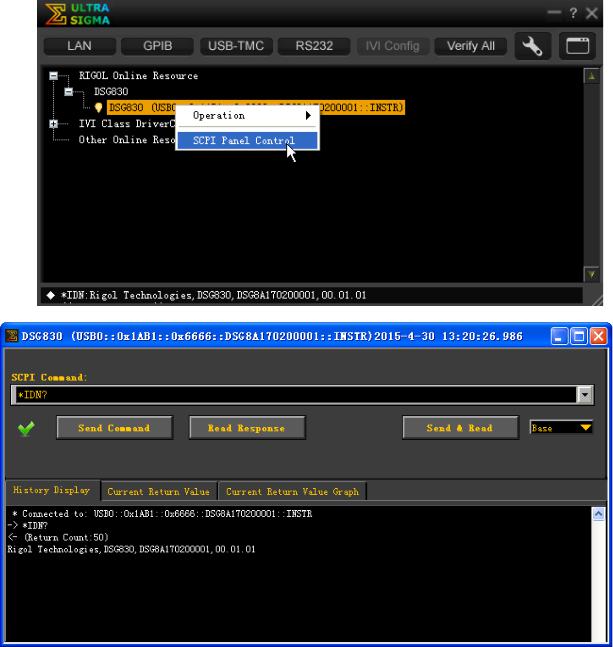
Chapter 1 Programming Overview |
RIGOL |
Remote Control Methods
1.User-defined programming
You can program and control DSG800 using the SCPI (Standard Commands for Programmable Instruments) commands listed in chapter 2 Command System in various development environments (such as Visual C++, Visual Basic and LabVIEW). For the details, refer to the introductions in chapter 4 Programming Demos.
2.Send SCPI commands via PC software
You can use the PC software Ultra Sigma (provided by RIGOL) to send SCPI commands to control the RF signal generator remotely.
DSG800 Programming Guide |
1-3 |

RIGOL |
Chapter 1 Programming Overview |
SCPI Command Overview
SCPI (Standard Commands for Programmable Instruments) is a standardized instrument programming language that is based on the standard IEEE488.1 and IEEE488.2 and conforms to various standards (such as the floating point operation rule in IEEE754 standard, ISO646 7-bit coded character for information interchange (equivalent to ASCll programming)). This chapter describes the syntax, symbols, parameters and abbreviation rules of the SCPI commands.
Syntax
SCPI commands present a hierarchical tree structure and have multiple sub-systems, each of which contains a root keyword and one or more sub-keywords. The command string usually begins with ":"; the keywords are separted by ":" and are followed by the parameter settings available; "?" is added at the end of the command string to indicate query; space is used to separate the command and parameter.
For example, :SYSTem:COMMunication:LAN:IP:ADDress <value> :SYSTem:COMMunication:LAN:IP:ADDress?
SYSTem is the root keyword of the command above. COMMunication, LAN, IP and ADDress are the second-level, third-level, forth-level and fifth-level keywords respectively. The command string begins with ":" which is also used to separate the multi-level keywords. <value> denotes the parameter available for setting. "?" denotes query and the RF signal generator returns the response information (the output value or internal setting value of the instrument) when receiving a query command. The
command :SYSTem:COMMunication:LAN:IP:ADDress and prarameter <value> are separated by a space.
"," is generally used for separating different parameters contained in the same command; for example, [:SOURce]:SWEep:LIST:LIST? <Start>,<Count>
Symbol Description
The following four symbols are not the content of SCPI commands and will not be sent with the command; but, they are usually used to describe the parameters in the commands.
1.Braces { }
Multiple optional parameters are enclosed in the braces and one of the parameters must be selected when sending the command.
2.Vertical Bar |
The vartical bar is used to separate multiple parameters. When you send a command, one of the parameters must be selected. For example, the :SYSTem:LANGuage CHINese|ENGLish command.
3.Square Brackets [ ]
The contents (command keywords) enclosed in the square brackets are optional and will be executed no matter whether they are omitted or not. For example, for the [:SOURce]:AM[:DEPTh]? command, sending any of the four commands below can generate the same effect.
:AM?
:AM:DEPTh?
:SOURce:AM?
:SOURce:AM:DEPTh?
4.Triangle Brackets < >
The parameter enclosed in the triangle brackets must be replaced by an effective value. For example, send the [:SOURce]:FREQuency <value> command in :FREQuency 4MHz form.
1-4 |
DSG800 Programming Guide |
Chapter 1 Programming Overview |
RIGOL |
Parameter Type
The parameters of the commands introduced in this manual contains 5 types: bool, integer, real number, discrete and ASCII string.
1.Bool
The parameter could be OFF, ON, 0 or 1. For example, [:SOURce]:AM:STATe ON|OFF|1|0.
2.Integer
Unless otherwise noted, the parameter can be any integer within the effective value range. Note that do not set the parameter to a decimal; otherwise, errors will occur. For example, in
the :SYSTem:BRIGhtness <value> command, <value> can be any integer from 1 to 8.
3.Real Number
Unless otherwise noted, the parameter can be any value within the effective value range.
For example, <value> in the [:SOURce]:AM:FREQuency <value> command can be any real number from 10Hz to 100kHz.
4.Discrete
The parameter could only be one of the specified values or characters. For example, in the [:SOURce]:AM:WAVEform SINE|SQUA command, the parameter can only be SINE or SQUA.
5.ASCII String
The parameter should be the combinations of ASCII characters. For example, in the :MMEMory:SAVe <file_name> command, <file_name> is the filename of the file to be saved and can include Chinese characters (a Chinese character occupies two bytes), English characters and numbers. The filename cannot exceed 28 bytes.
Command Abbreviation
All the commands are case-insensitive and you can use any of them. If abbreviation is used, all the capital letters in the command must be written completely. For example, the :MMEMory:DISK:FORMat command can be abbreviated to :MMEM:DISK:FORM.
DSG800 Programming Guide |
1-5 |
Chapter 2 Command System |
RIGOL |
Chapter 2 Command System
This chapter introduces the syntax, function, parameter and using instruction of each DSG800 command in alphabetical (A to Z) order.
Main topics of this chapter:
IEEE488.2 Common Commands
:MMEMory Commands
:OUTPut Command
:SOURce Commands
:STATus Commands
:SYSTem Commands
:TRIGger Commands
:UNIT Command
DSG800 Programming Guide |
2-1 |

RIGOL |
Chapter 2 Command System |
IEEE488.2 Common Commands
The IEEE488.2 common commands are used to query the basic information about the instrument or execute common operations. These commands usually begin with "*", contain a 3-character command keyword and relate to the status register.
Command List[1] :
*IDN?
*TRG
*IDN?
Syntax *IDN?
Description Query the ID string of the instrument.
Return Format The query returns the ID string of the instrument. For example, Rigol Technologies,DSG830,DSG8A170200001,00.01.01.
*TRG
Syntax *TRG
Description Trigger a pulse modulation, RF sweep or IQ wavetable output immediately. Related :TRIGger:IQ[:IMMediate]
Commands :TRIGger:PULSe[:IMMediate] :TRIGger[:SWEep][:IMMediate]
Note[1]: In the "Command List" in this manual, the parameters in the setting commands and the query commands are not included and you can refer to the complete introductions of the commands in the text according to the keywords.
2-2 |
DSG800 Programming Guide |
Chapter 2 Command System |
RIGOL |
:MMEMory Commands
The :MMEMory commands are used to store files to the internal or external memory of the instrument, read or delete the specified file as well as query the disk information.
Command List:
:MMEMory:CATalog
:MMEMory:CATalog:LENGth
:MMEMory:COPY
:MMEMory:DATA:IQ
:MMEMory:DATA:IQ:LIST
:MMEMory:DELete
:MMEMory:DISK:FORMat
:MMEMory:DISK:INFormation
:MMEMory:FILEtype
:MMEMory:LDISk:SPACe
:MMEMory:LOAD
:MMEMory:MDIRectory
:MMEMory:MOVE
:MMEMory:PNAMe:EDIT
:MMEMory:PNAMe:STATe
:MMEMory:SAVe
:MMEMory:CATalog
Syntax |
:MMEMory:CATalog? <path> |
|
|
||
Description |
Query all the files and folders under the specified path. |
|
|||
Parameter |
Name |
Type |
Range |
Default |
|
|
|
<path> |
ASCII string |
Valid path |
-- |
|
|
|
|
|
|
Explanation |
<path>: the local memory (D disk), external memory (E disk; when a USB |
||||
storage device is detected by the USB HOST interface at the rear panel) or the subdirectory under the D or E disk.
The query returns a list of all the files and folders under the path specified by <path>.
Return Format NO.1 File Name: Rigol
NO.2 File Name: 4.STA
Example :MMEM:CAT? D:
DSG800 Programming Guide |
2-3 |

RIGOL Chapter 2 Command System
:MMEMory:CATalog:LENGth
Syntax |
:MMEMory:CATalog:LENGth? <path> |
|
|
||||
Description |
Query the number of files and folders under the specified path. |
|
|||||
Parameter |
Name |
|
|
Type |
|
Range |
Default |
|
<path> |
|
ASCII string |
|
Valid path |
-- |
|
Explanation |
<path> can be the local memory (D disk), external memory (E disk; when a USB |
||||||
|
storage device is detected by the USB HOST interface at the rear panel) or the |
||||||
|
subdirectory under the D or E disk. |
|
|
||||
Return Format |
The query returns an integer. For example, 2. |
|
|
||||
Example |
:MMEM:CAT:LENG? D: |
/*Query and return the number of files and folders in the |
|||||
|
|
|
|
D disk*/ |
|
|
|
:MMEMory:COPY
Syntax :MMEMory:COPY <file_source>,<file_destination>
Description Copy the file or folder specified by <file_source> to the destination path specified by <file_destination>.
Parameter |
Name |
|
Type |
Range |
Default |
|
|
||||||
|
|
<file_source> |
|
ASCII string |
The name of the file or folder to |
-- |
|
|
|
|
|
be copied |
|
|
|
<file_destination> |
|
ASCII string |
Valid destination path |
-- |
Explanation |
<file_source> denotes the file or folder to be copied. The file or folder name |
|||||
|
|
must contain the path. <file_destination> denotes the destination path and |
||||
|
|
does not include the filename. |
|
|
||
If the file or folder specified by <file_source> does not exist, the operation fails.
If the destination path specified by <file_destination> does not exist, the copy operation fails.
Example :MMEM:COPY D:\1.STA,D:\
2-4 |
DSG800 Programming Guide |

Chapter 2 Command System RIGOL
:MMEMory:DATA:IQ
Syntax |
:MMEMory:DATA:IQ <file_name>,<flag>,<num>{,<i0>,<q0>…<in>,<qn>} |
|||
Description Save and download IQ waveform data to the instrument. |
||||
Parameter |
Name |
Type |
Explanation |
|
|
|
<file_name> |
ASCII string |
The name of the wavetable file downloaded |
|
|
|
|
into the instrument. |
|
|
|
|
When the IQ data file exceeds 64kB, you |
|
|
|
|
should download the file packets separately. |
|
|
|
|
0 denotes downloading the first data packet; |
|
|
<flag> |
Discrete |
1 denotes downloading the subsequent data |
|
|
|
|
packets; |
|
|
|
|
2 denotes downloading the last data packet |
|
|
|
|
and output the IQ waveform. |
|
|
<num> |
Integer |
The number of IQ data pairs. |
|
|
{,<i0>,<q0>… |
Decimal |
IQ data pairs. Each data (for example, i0) |
|
|
<in>,<qn>} |
number |
cannot exceed two bytes. |
Explanation When sending the command, you should add the data block (start with #9 flag) which denotes the total length of the IQ data before <i0>,<q0>…<in>,<qn>. For example, #9000000011 denotes that the total length of the IQ data is 11 bytes. The value is calculated by the formula "the number of bytes of the IQ data pairs + the number of bytes occupied by the commas".
Example :MMEM:DATA:IQ test1,0,2,#9000000011 1,10,11,20
/*Save the two pairs of IQ data currently edited with the filename "test1" (the total length of "1,10,11,20" is 11 bytes and is expressed by #9000000011) and download the IQ data to DSG800*/
:MMEMory:DATA:IQ:LIST
Syntax :MMEMory:DATA:IQ:LIST?
Description Query the wavetable files currently stored in the root directory (D: disk) of the instrument.
Return Format The query returns the wavetable file list in the format of "wavetable filename (*.arb),file size". For example, wave2.arb,2180,wave3.arb,2516,.
DSG800 Programming Guide |
2-5 |

RIGOL Chapter 2 Command System
:MMEMory:DELete
Syntax |
:MMEMory:DELete <file_name> |
|
|
|
|||
Description |
Delete the specified file or folder under the specified operation path. |
|
|||||
Parameter |
Name |
Type |
|
Range |
|
Default |
|
|
|
<file_name> |
ASCII string |
|
The name of the file or folder to |
|
-- |
|
|
|
be deleted |
|
|||
|
|
|
|
|
|
|
|
Explanation |
This command is valid only when the specified file or folder exists under the |
||||||
|
|
current operation path or the specified path. |
|
||||
<file_name> can be the name of a file or folder under the current operation path or a file or folder name containing the specified path. For
example, :MMEM:DEL D:\NEW\8.STA.
Example :MMEM:DEL 8.STA |
/*Delete the file named "8.STA" under the current operation |
|
path*/ |
:MMEMory:DISK:FORMat
Syntax :MMEMory:DISK:FORMat Description Format the local disk (D disk).
:MMEMory:DISK:INFormation
Syntax |
:MMEMory:DISK:INFormation? <Disk> |
|
|
|
|
|
|||||||
Description |
Query the information of the local disk. |
|
|
|
|
|
|||||||
Parameter |
|
Name |
|
|
Type |
|
|
Range |
|
|
Default |
|
|
|
|
|
<Disk> |
|
ASCII string |
|
D: (or LOCAL) |
|
D: (or LOCAL) |
||||
Return Format The query returns the information of the local disk, including the disk name, file system, total space, used space and free space. For example,
Disk:D: (or Disk:LOCAL) |
|
File Sys:FAT32 |
|
Total:1.0 GB |
|
Used:512 KB |
|
Free:0.99 GB |
|
Example :MMEM:DISK:INF? D: |
/*The query returns the information of D disk*/ |
2-6 |
DSG800 Programming Guide |
Chapter 2 Command System |
RIGOL |
:MMEMory:FILEtype
Syntax :MMEMory:FILEtype ALL|STATe|ARB|FLACsv|SWPCsv|TRNCsv|SEGMent|SEQList|SEQCsv
|
|
:MMEMory:FILEtype? |
|
|
|
Description Set the file type. |
|
|
|
||
|
|
Query the current file type. |
|
|
|
Parameter |
|
|
|
|
|
Name |
Type |
Range |
Default |
||
|
|
ALL|STATe|ARB|FLACsv|S |
|
ALL|STATe|ARB|FLACsv|S |
|
|
|
WPCsv|TRNCsv|SEGMent| |
Discrete |
WPCsv|TRNCsv|SEGMent| |
ALL |
|
|
SEQList|SEQCsv |
|
SEQList|SEQCsv |
|
|
|
|
|
|
|
Explanation |
The file types available are all, state, Arb, flatness csv, sweep csv, train csv, |
||||
|
|
segment, seg list and seg csv. |
|
|
|
After selecting the corresponding file type, you can view all the files of this file type or save a new file of this file type.
Return Format The query returns ALL, STATE, ARB, FLACSV, SWPCSV, TRNCSV, SEGMENT, SEQLIST or SEQCSV.
Example :MMEM:FILE STATe |
/*Set the file type to "State"*/ |
:MMEM:FILE? |
/*Query the current file type and the query returns |
|
STATE*/ |
:MMEMory:LDISk:SPACe
Syntax :MMEMory:LDISk:SPACe?
Description Query the space information of the local disk (D disk).
Return Format The query returns the D disk space information including the "Used space" and "Free space". For example, Used:512 k,Free:1048064 k.
:MMEMory:LOAD
Syntax |
:MMEMory:LOAD <file_name> |
|
|
|
|
|
|
|||
Description |
Read the specified file in the specified operation path. |
|
|
|
||||||
Parameter |
|
Name |
|
Type |
|
Range |
|
Default |
|
|
|
|
|
<file_name> |
|
ASCII |
|
The name of the file to be |
|
-- |
|
|
|
|
|
string |
|
read |
|
|
||
|
|
|
|
|
|
|
|
|
||
Explanation |
This command is valid only when the specified file exists under the current |
|
||||||||
|
|
|
operation path or the specified path. |
|
|
|
|
|
||
<file_name> can be the name of a file under the current operation path or a file name containing the specified path. For example, MMEM:LOAD D:\NEW\2.STA.
Example :MMEM:LOAD 2.STA |
/*Read the file named "2.STA" under the current operation |
|
path*/ |
DSG800 Programming Guide |
2-7 |

RIGOL Chapter 2 Command System
:MMEMory:MDIRectory
Syntax |
:MMEMory:MDIRectory <directory_name> |
|
|||
Description |
Create a new folder under the specified operation path. |
|
|||
Parameter |
Name |
Type |
Range |
Default |
|
|
|
<directory_name> |
ASCII string |
The name of the folder to be |
-- |
|
|
created |
|||
|
|
|
|
|
|
Explanation |
The folder name can include Chinese characters (a Chinese character occupies |
||||
|
|
two bytes), English characters or numbers. The folder name cannot exceed 28 |
|||
|
|
bytes. |
|
|
|
If the name of the folder to be created already exists, this operation is invalid. At this point, "The filename already exists" is displayed in the user interface.
<directory_name> can be a new folder name that does not contain the path (denote creating a folder under the current operation path) or a folder name that contains the specified path (denote creating a new folder under the specified path; for example, :MMEM:MDIR D:\1\NEW).
Example :MMEM:MDIR NEW |
/*Create a folder named "NEW" under the current operation |
|
path*/ |
:MMEMory:MOVE
Syntax :MMEMory:MOVE <file_source>,<file_destination>
Description Rename the file or folder specified by <file_source> as the destination file or folder name specified by <file_destination>.
Parameter |
Name |
Type |
|
Range |
Default |
|
|
||||||
|
|
<file_source> |
ASCII string |
Valid file or folder name |
-- |
|
|
|
<file_destination> |
||||
Explanation |
The file or folder names specified by <file_source> and <file_destination> |
|||||
|
|
must contain the path. |
|
|
||
If the file or folder specified by <file_source> does not exist, the rename operation fails.
If the destination file or folder name specified by <file_destination> already exists under the current path, the rename operation fails.
Example :MMEM:MOVE D:\1.STA, D:\2.STA
2-8 |
DSG800 Programming Guide |
Chapter 2 Command System |
RIGOL |
:MMEMory:PNAMe:EDIT
Syntax :MMEMory:PNAMe:EDIT <pre_name> :MMEMory:PNAMe:EDIT?
Description Edit and save the filename prefix. Query the filename prefix saved.
Parameter |
Name |
|
Type |
Range |
Default |
|
<pre_name> |
ASCII string |
The filename prefix to be edited |
-- |
|
Explanation |
You can edit any filename prefix. |
|
|
||
Return Format |
The query returns the filename prefix. For example, N. |
|
|||
Example |
:MMEM:PNAM:EDIT N |
/*Edit the filename prefix as N*/ |
|
||
|
:MMEM:PNAM:EDIT? |
/*The query returns N*/ |
|
||
Related |
:MMEMory:PNAMe:STATe |
|
|
||
Command |
|
|
|
|
|
:MMEMory:PNAMe:STATe
Syntax :MMEMory:PNAMe:STATe ON|OFF|1|0 :MMEMory:PNAMe:STATe?
Description Turn on or off the filename prefix.
Query the current on/off state of the filename prefix.
Parameter |
Name |
|
Type |
Range |
Default |
|
ON|OFF|1|0 |
|
Bool |
ON|OFF|1|0 |
OFF|0 |
Explanation |
ON|1: turn on the filename prefix edited. |
|
|||
|
OFF|0: turn off the filename prefix edited. |
|
|||
|
If the filename prefix is turned on, the prefix edited will be added to the |
||||
|
filename input box automatically when saving a file. |
|
|||
Return Format |
The query returns 0 or 1. |
|
|
||
Example |
:MMEM:PNAM:STATe ON |
|
|
||
|
:MMEM:PNAM:STAT? |
|
|
|
|
Related |
:MMEMory:PNAMe:EDIT |
|
|
||
Command |
|
|
|
|
|
DSG800 Programming Guide |
2-9 |

RIGOL Chapter 2 Command System
:MMEMory:SAVe
Syntax |
:MMEMory:SAVe <File_name> |
|
|
||
Description |
Save the file with the specified filename under the current operation path. |
||||
Parameter |
Name |
Type |
Range |
Default |
|
|
|
<file_name> |
ASCII string |
The name of the file to be saved |
-- |
Explanation |
The filename can include Chinese characters (a Chinese character occupies two |
||||
|
|
bytes), English characters or numbers. The filename cannot exceed 28 bytes. |
|||
When the current path already contains a file with the same name, this command will directly overwrite the original file.
Example :MMEM:SAV SET.STA |
/*Save the current instrument state with the filename |
|
"SET.STA" under the current operation path*/ |
2-10 |
DSG800 Programming Guide |
